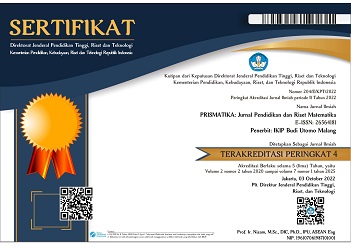PENGEMBANGAN LEMBAR KERJA SISWA BERBASIS CORE (CONNECTING, ORGANIZING, EXTENDING, DAN REFLECTING) PADA MATERI SISTEM PERSAMAAN LINIER DUA VARIABEL
Abstract
Student worksheets (LKS) are student guides in solving problems. LKS based on CORE (Connecting, Organizing, Extending, and Reflecting) on the material of a two-variable equation system had advantages in presenting the material and had an attractive appearance. The development model used ADDIE model. The subjects of this study were 20 students of SMAN 1 Nggaha Ori Angu. The data collection process used an instrument in the form of a validation sheet with the aim of measuring the validity of the LKS, post-test to determine student learning outcomes and student responses to the LKS developed to determine the effectiveness of the LKS. The results of data analysis showed that from the two validators the average value was 3.32 which showed the valid criteria. The percentage of students' average completeness score was 78%. Based on the established criteria, it can be said that students had good mastery of the SPLDV material. The student response questionnaire data obtained a percentage of 85.7%, so based on the criteria it was concluded that students showed a positive response to the developed LKS. Overall, the CORE-based LKS on SPLDV material was effectively used in the learning process.
References
Arofah, R. . dan C. H. (2019). Pengembangan Bahan Ajar Berbasis ADDIE Model. Islamic Education Journal, 3(1), 35–43.
Bruning, dkk. (2010). Cognitive psychology and instruction (5th ed.). Pearson Education Inc.
Caine, R. N. . danEducation on the edge of possibility C. G. (1997). Education on the edge of possibility. Association for Supervision and Curriculum Development.
Curwen, dkk. (2010). Increasing teachers’ metacognition develops students’ higher learning during content area literacy instruction: Findings from the read-write cycle project. Issues in Teacher Education, 19(2), 127–151.
Deswita, R. (2015). Penerapan model pembelajaran connecting-organizing- reflecting-extending (CORE) dengan pendekatan scientific untuk meningkatkan kemampuan komunikasi dan koneksi matematis serta self- efficacy siswa SMP: Studi kuasi eksperimen pada salah satu SMP negeri. Universitas Pendidikan Indonesia.
Dewi, M., & Izzati, N. (2020). Pengembangan Media Pembelajaran PowerPoint Interaktif Berbasis RME Materi Aljabar Kelas VII SMP. Delta: Jurnal Ilmiah Pendidikan Matematika, 8(2), 217. https://doi.org/10.31941/delta.v8i2.1039
Dymock, S. (2005). Teaching Expository Text Structure Awareness. The Reading Teacher, 59(2), 177–181. https://doi.org/10.1598/RT.59.2.7
Fannie, R. D. dan R. (2014). Pengembangan Lembar Kerja Siswa Berbasis POE (Predict, Observe, Explain) pada Materi Program Linear Kelas XII SMA. Jurnal Sainmatika, 8(1), 96–109.
Henson, K. T. . dan E. B. F. (2012). Educational psychology for effective teaching. Kendall Hunt.
Hosnan, M. . dan S. R. (2014). Pendekatan saintifik dan kontekstual dalam pembelajaran abad 21: Kunci sukses implementasi kurikulum 2013. Ghalia Indonesia.
Istiqlal, M. (2017). Pengembangan Multimedia Interaktif Dalam Pembelajaran Matematika. Jurnal Ilmiah Pendidikan Matematika, 2(1), 43–54.
Menteri Pendidikan dan Kebudayaan Republik Indonesia. (2014). eraturan Menteri Pendidikan dan Kebudayaan Republik Indonesia nomor 59 tahun 2014 tentang Kurikulum 2013 SMA/MA.
Miller, R. G. . dan C. R. C. (2004). Making thinking visible: A method to encourage science writing in upper elementary grades. Science and Children, 42(2), 20–25.
Nugroho, D. A. (2019). Pengembangan perangkat pembelajaran geometri dengan mengadaptasi model CORE untuk meningkatkan efikasi diri. Jurnal Riset Pendidikan Matematika, 6(1), 39–52. https://doi.org/10.21831/jrpm.v6i1.11599
Nurfayziah, P. (2012). Peningkatan kemampuan koneksi matematis dan self- efficacy siswa SMP melalui pembelajaran matematika model CORE. Universitas Pendidikan Indonesia.
Prastowo, A. (2014). Pengembangan Bahan Ajar Tematik :Tinjauan Teoretis dan
Praktik. Kencana Prenada Group.
Purnomo, A. D. (2017). Pengembangan Game Untuk Terapi membaca Bagi Anak Disleksia Dan Diskalkulia. Jurnal Simetris, 8(2), 497–506.
Rasyid, dkk. (2016). Pengembangan Media Pembelajaran Berbasis Multimedia.
Jurnal Pendidikan Biologi, 7(2), 69–80.
Rochmad. (2012). Desain Model Pengembangan Perangkat Pembelajaran Matematika. Jurnal Kreano, 3(1), 59–72.
Suyatno, D. (2009). Menjelajah pembelajaran inovatif. Sidoarjo: Masmedia Buana Pustaka.
Trianto, T. (2010). Model pembelajaran terpadu: Konsep, strategi, dan implementasinya dalam Kurikulum Tingkat Satuan Pendidikan (KTSP). Jakarta: Bumi Aksara.







.png)




